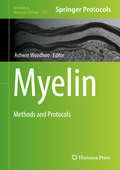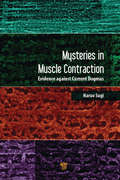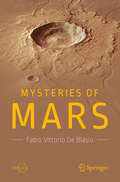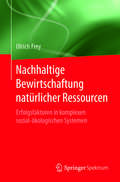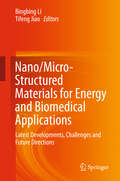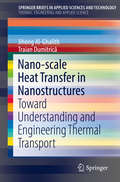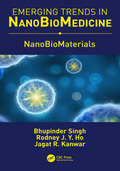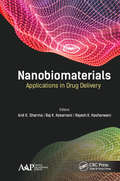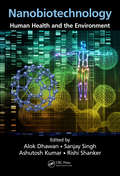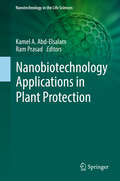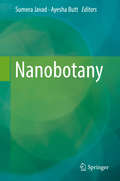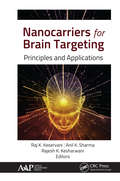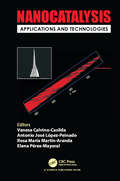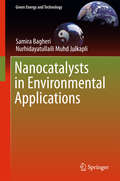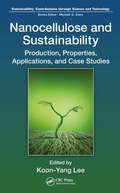- Table View
- List View
Myelin: Methods and Protocols (Methods in Molecular Biology #1791)
by Ashwin WoodhooThis volume collects research methodologies for both basic and translational studies of myelin authored by experts in the field. Chapters in this book are divided into three parts: Part One focuses on visualizing myelin and studying it on a biochemical level; Part Two looks at cell culture systems used to uncover key mechanisms that regulate formation and maintenance of myelin; and Part Three discusses modeling disorders of myelin in both CNS and PNS, and therapeutic strategies for targeting these disorders. Written in the highly successful Methods in Molecular Biology series format, chapters include introductions to their respective topics, lists of the necessary materials and reagents, step-by-step, readily reproducible laboratory protocols, and tips on troubleshooting and avoiding known pitfalls.Cutting-edge and comprehensive, Myelin: Methods and Protocols is a valuable resource for physiologists, molecular biologists, anatomists, cell and developmental biologists, and physician-scientists working in the field of myelin biology and the disorders associated with it.
Mysteries in Muscle Contraction: Evidence against Current Dogmas
by Haruo SugiThis book explores the author’s wide-ranging work on muscle research, which spans more than 50 years. It delves into the dogmas of muscle contraction: how the models were constructed and what was overlooked during the process, including their resulting shortcomings. The text stimulates general readers’ and researchers’ interest, highlights the author’s pioneering work on the electron microscopic recording of myosin head power and recovery strokes, and presents a frank discussion on how the original work sometimes tends to be overlooked by competing scientists, who hinder the progress of science.
Mysteries in Muscle Contraction: Evidence against Current Dogmas
by Haruo SugiThis book explores the author’s wide-ranging work on muscle research, which spans more than 50 years. It delves into the dogmas of muscle contraction: how the models were constructed and what was overlooked during the process, including their resulting shortcomings. The text stimulates general readers’ and researchers’ interest, highlights the author’s pioneering work on the electron microscopic recording of myosin head power and recovery strokes, and presents a frank discussion on how the original work sometimes tends to be overlooked by competing scientists, who hinder the progress of science.
Mysteries of Mars (Springer Praxis Books)
by Fabio Vittorio De BlasioThis book introduces the reader to the wonders of Mars, covering all aspects from our past perceptions of the planet through to the latest knowledge on its history, its surface processes such as impact cratering, volcano formation, and glaciation, and its atmosphere and climate. In addition, a series of ten intriguing open issues are considered in a more advanced way. These include such thought-provoking questions as What turned off the planet’s magnetic field?, Why are the northern and southern hemispheres so different?, What was the fate of the once abundant water?, and Is there, or was there, life on Mars? Numerous original figures, unavailable elsewhere, reproduce details of images from Viking, CTX, MOC, HiRISE, THEMIS, and HRSC. The book will appeal especially to general readers interested in planetary sciences, astronomy, astrogeology, and space exploration and to students of Earth Sciences and Natural and Environmental Sciences. The higher-level materialon the remaining mysteries of Mars will also be of interest to astrogeologists and other researchers.
Nachhaltige Bewirtschaftung natürlicher Ressourcen: Erfolgsfaktoren in komplexen sozial-ökologischen Systemen
by Ulrich FreyDieses Buch analysiert die wichtigsten Einflussfaktoren für das Management sozial-ökologischer Systeme. An vielen natürlichen Ressourcen betreibt der Mensch Raubbau. Dennoch gibt es Gegenbeispiele nachhaltiger Nutzung von Gemeingütern. Wichtige Fragen wie zum Beispiel: Was zeichnet erfolgreiche Nutzung aus? werden in diesem Buch beantwortet. Anhand von drei der weltweit größten Datensätze zu Fischerei-, Waldbewirtschaftungs- und Bewässerungssystemen werden Erfolgsfaktoren empirisch untersucht und für den Leser einzeln beleuchtet. Das Buch entwickelt über eine Bandbreite von Methoden – Regressionen, Entscheidungswälder und neuronale Netzwerke – prognosestarke und robuste empirisch fundierte Modelle,um ein neues Licht auf bereits häufig untersuchte Faktoren zu werfen, wie zum Beispiel Konfliktlösungsmechanismen. Der Autor stellt 24 Erfolgsfaktoren als Synthese aus seinen Modellen vor, die den ökologischen Erfolg in der Bewirtschaftung natürlicher Ressourcen sehr gut erklären.
Nachhaltige Schulverpflegung an Berufskollegs: Verpflegungssysteme und Ernährungsbildung (Forschungsreihe der FH Münster)
by Jill Katrin HergemöllerDie Schulverpflegung an Berufskollegs für junge Erwachsene, die sich auf ihrem Weg in die Selbstständigkeit befinden, wird im Vergleich zur Diskussion um die Versorgung in Ganztagsschulen in der Fachwelt und in der öffentlichen Wahrnehmung vernachlässigt. Jill Katrin Hergemöller zeigt auf, wie wichtig die Einbindung der Nachhaltigkeit in die Schulverpflegung an Berufskollegs und berufsbildenden Schulen ist und entwickelt Vorschläge, um Schülerinnen und Schüler, insbesondere des Berufsfelds Ernährung und Hauswirtschaft, in die Schulverpflegung einzubinden.
Nachhaltiges Planen, Bauen und Wohnen: Kriterien für Neubau und Bauen im Bestand
by Stefanie FriedrichsenDeutschland ist gebaut: Drei Viertel aller Wohngebäude sind über 30 Jahre alt und müssten dringend modernisiert werden. Das Werk bietet einen Überblick darüber, welche Kriterien bei einer umfassenden Modernisierung beachtet werden müssen, um eine wirtschaftlich tragfähige, sozialverträgliche und umweltgerechte Lösung zu finden. Der Schwerpunkt liegt dabei auf Mehrfamilienhäusern. Jedes Kapitel bietet umfangreiche Checklisten, mit deren Hilfe Modernisierungsaufgaben systematisch angegangen werden können.
Nachhaltigkeit in der Lehre: Eine Herausforderung für Hochschulen (Theorie und Praxis der Nachhaltigkeit #19)
by Walter Leal FilhoDieses Buch richtet sich an alle, die das Thema Nachhaltigkeit in der Lehre behandeln möchten. Es trägt zum Erfahrungs- und Informationsaustausch zwischen Lehrenden und Wissenschaftlern bei, und stellt erfolgreiche Ansätze vor, wie das Thema Nachhaltigkeit in der Lehre vermittelt werden kann. An zahlreichen Hochschulen gibt es bereits interessante und attraktive Lehrangebote zu Nachhaltigkeit. Dabei sollte es nicht nur um die Vermittlung von Sachwissen gehen. Nachhaltigkeit in der Lehre beinhaltet, dass sowohl Wissen als auch pragmatische Handlungskompetenzen bei den Studierenden durch inter-, trans- und multidisziplinäre Ansätze gefördert werden. Gerade jetzt, da die Staaten weltweit anstreben, die UN Nachhaltigkeitsziele umzusetzen, ist es dringend erforderlich, dass Nachhaltigkeit in der Lehre durch eine Kombination von Theorie und Praxis eingeführt wird. Hier setzt diese Buch an und zeigt neue Wege auf, wie das Thema Nachhaltigkeit ganzheitlich in der Lehre vermittelt werden kann.
Nano/Micro-Structured Materials for Energy and Biomedical Applications: Latest Developments, Challenges and Future Directions
by Bingbing Li Tifeng JiaoThis book discusses the latest developments of the synthesis, preparation, characterization, and applications of nano/microstructure-based materials in biomedical and energetic fields. It introduces several popular approaches to fabricating these materials, including template-assisted fabrication, electrospinning of organic/inorganic hybrid materials, biomineralization-mediated self-assembly, etc. The latest results in material evaluation for targeted applications are also presented. In particular, the book highlights the latest advances and future challenges in polymer nanodielectrics for energy storage applications. As such, it offers a valuable reference guide for scholars interested in the synthesis and evaluation of nano/microstructure-based materials, as well as their biomedical and energetic applications. It also provides essential insights for graduate students and scientists pursuing research in the broad fields of composite materials, polymers, organic/inorganic hybrid materials, nano-assembly, etc.
Nano-scale Heat Transfer in Nanostructures: Toward Understanding and Engineering Thermal Transport (SpringerBriefs in Applied Sciences and Technology)
by Jihong Al-Ghalith Traian DumitricăThe book introduces modern atomistic techniques for predicting heat transfer in nanostructures, and discusses the applications of these techniques on three modern topics. The study of heat transport in screw-dislocated nanowires with low thermal conductivity in their bulk form represents the knowledge base needed for engineering thermal transport in advanced thermoelectric and electronic materials, and suggests a new route to lower thermal conductivity that could promote thermoelectricity. The study of high-temperature coating composite materials facilitates the understanding of the role played by composition and structural characterization, which is difficult to approach via experiments. And the understanding of the impact of deformations, such as bending and collapsing on thermal transport along carbon nanotubes, is important as carbon nanotubes, due to their exceptional thermal and mechanical properties, are excellent material candidates in a variety of applications, including thermal interface materials, thermal switches and composite materials.
NanoBioMaterials
by Bhupinder SinghThe present book volume presents a holistic view of the aspects of nanobiomaterials incl. their stellar merits and limitations, applications in diverse fields, their futuristic promise in the fields of biomedical science and drug delivery. The federal & regulatory issues on the usage of nanobiomaterials have been assigned due consideration.
Nanobiomaterials: Applications in Drug Delivery
by Anil K. Sharma Raj K. Keservani Rajesh K. KesharwaniThis new volume focuses on the ever-growing and ever-sophisticated use of nanobiomaterials in drug delivery. There have been significant developments in the delivery of the active pharmaceutical ingredients to target sites, thereby sparing the normal functioning biological systems from damage, and this volume highlights some of the most important developments in the field. The book first provides an overview of nanobiomaterials and then goes on to report on new developments in drug delivery and nanotechnology, nanobiomaterials as carriers in cancer therapy, and the diverse uses of nanobiomaterials. Broken into sections, the chapters cover: an overview of nanobiomaterials drug delivery and nanotechnology nanobiomaterials as carriers in cancer therapeutics diverse uses of nanobiomaterials This volume will be a valuable resource on drug delivery for pharmaceutical manufacturers, healthcare personnel, and researchers.
Nanobiomaterials: Applications in Drug Delivery
by Anil K. Sharma Raj K. Keservani Rajesh K. KesharwaniThis new volume focuses on the ever-growing and ever-sophisticated use of nanobiomaterials in drug delivery. There have been significant developments in the delivery of the active pharmaceutical ingredients to target sites, thereby sparing the normal functioning biological systems from damage, and this volume highlights some of the most important developments in the field. The book first provides an overview of nanobiomaterials and then goes on to report on new developments in drug delivery and nanotechnology, nanobiomaterials as carriers in cancer therapy, and the diverse uses of nanobiomaterials. Broken into sections, the chapters cover: an overview of nanobiomaterials drug delivery and nanotechnology nanobiomaterials as carriers in cancer therapeutics diverse uses of nanobiomaterials This volume will be a valuable resource on drug delivery for pharmaceutical manufacturers, healthcare personnel, and researchers.
NanoBioMaterials
by Bhupinder Singh Rodney J. Y. Ho Jagat R. KanwarThe present book volume presents a holistic view of the aspects of nanobiomaterials incl. their stellar merits and limitations, applications in diverse fields, their futuristic promise in the fields of biomedical science and drug delivery. The federal & regulatory issues on the usage of nanobiomaterials have been assigned due consideration.
Nanobiotechnology: Human Health and the Environment
by Alok Dhawan Sanjay Singh Ashutosh Kumar Rishi ShankerThis book combines the contributions from the experts of material science, molecular biology, toxicology bio-organic and bio-inorganic chemistry, toxicologists and environmental and food technology etc. to fathom the full scope of current and future of developments in the area of Nanobiotechnology. Provides brief overview of nanobiotechnology for general readers who are not familiar with the research fields and presents a strong overview of most of the critical areas in field This book can also be used as text book for graduate students as an essential reference material, and as an reading material for general readers having a curiosity in Nanobiotechnology.
Nanobiotechnology: Human Health and the Environment
by Alok Dhawan, Sanjay Singh, Ashutosh Kumar and Rishi ShankerThis book combines the contributions from the experts of material science, molecular biology, toxicology bio-organic and bio-inorganic chemistry, toxicologists and environmental and food technology etc. to fathom the full scope of current and future of developments in the area of Nanobiotechnology. Provides brief overview of nanobiotechnology for general readers who are not familiar with the research fields and presents a strong overview of most of the critical areas in field This book can also be used as text book for graduate students as an essential reference material, and as an reading material for general readers having a curiosity in Nanobiotechnology.
Nanobiotechnology Applications in Plant Protection (Nanotechnology in the Life Sciences)
by Kamel A. Abd-Elsalam Ram PrasadNanotechnology can target specific agricultural problems related to plant pathology and provide new techniques for crop disease control. Plant breeders and phytopathologists are needed who can apply nanogenomics and develop nanodiagnostic technologies to accurately advance the improvement process and take advantage of the potential of genomics. This book serves as a thorough guide for researchers working with nanotechnology to address plant protection problems.Novel nanobiotechnology methods describe new plant gene transfer tools that improve crop resistance against plant diseases and increase food security. Also, quantum dots (QDs) have emerged as essential tools for fast and accurate detection of particular biological markers. Biosensors, QDs, nanostructured platforms, nanoimaging, and nanopore DNA sequencing tools have the potential to raise sensitivity, specificity, and speed in pathogen detection, thereby facilitating high-throughput analysis and providing high-quality monitoring and crop protection. Also, this book deals with the application of nanotechnology for quicker, more cost-effective, and precise diagnostic procedures of plant diseases and mycotoxins. Applications of nanotechnology in plant pests and disease control, antimicrobial mechanisms, pesticides remediation and nanotoxicity on plant ecosystem and soil microbial communities are discussed in detail. Moreover, the application of specific nanomaterials including silver, copper, carbon- or polymer-based nanomaterials and nanoemulsions are also discussed. Crops treated with safe nanofertilizers and nanopesticides will gain added value because they are free of chemical residues, decay and putative pathogens for human health, sustaining the global demand for high product quality.
Nanobotany
by Sumera Javad Ayesha ButtThis work synthesizes research and practical work, including various techniques and applications of botany and nanoparticles, including enzymology, pharmaceuticals, phenolics, antioxidants, metal particles, synthesis of nanoparticles by plants and microbes, and more. The text discusses the latest research as well as key sources of information condensed from other scholars across the globe, providing a comprehensive resource for scholars working in nanobotany, as well as chemists and researchers in the pharmaceutical industry.
Nanocarriers for Brain Targeting: Principles and Applications
by Raj K. Keservani Anil K. Sharma Rajesh K. KesharwaniThis new volume, Nanocarriers for Brain Targeting: Principles and Applications, covers recent research on brain physiology and the development of drug delivery systems. It explores a diverse variety of strategies that can be employed to achieve drug targeting to the brain. The nanocarriers that are discussed include nanoparticles, vesicular carriers, carriers having carbon as a core constituent, dispersed systems, and more. The inherent anatomy and physiology of the brain renders it different from other organs. The past few decades have witnessed significant research on brain ailments in response to a majority of hospitalizations that occur due to age-related central nervous system disorders. The prevalence of diverse diseases such as Alzheimer’s disease, Parkinson’s disease, amyotrophic lateral sclerosis, multiple sclerosis, HIV-dementia, etc., affect about 1.5 billion people globally, which is further anticipated to reach 1.9 billion by the year 2020. Nanocarriers for drug delivery to the brain are seen as one of the answers to this growing problem.
Nanocarriers for Brain Targeting: Principles and Applications
by Raj K. Keservani Anil K. Sharma Rajesh K. KesharwaniThis new volume, Nanocarriers for Brain Targeting: Principles and Applications, covers recent research on brain physiology and the development of drug delivery systems. It explores a diverse variety of strategies that can be employed to achieve drug targeting to the brain. The nanocarriers that are discussed include nanoparticles, vesicular carriers, carriers having carbon as a core constituent, dispersed systems, and more. The inherent anatomy and physiology of the brain renders it different from other organs. The past few decades have witnessed significant research on brain ailments in response to a majority of hospitalizations that occur due to age-related central nervous system disorders. The prevalence of diverse diseases such as Alzheimer’s disease, Parkinson’s disease, amyotrophic lateral sclerosis, multiple sclerosis, HIV-dementia, etc., affect about 1.5 billion people globally, which is further anticipated to reach 1.9 billion by the year 2020. Nanocarriers for drug delivery to the brain are seen as one of the answers to this growing problem.
Nanocatalysis: Applications and Technologies
by Vanesa Calvino-Casilda Antonio José López-Peinado Rosa María Martín-Aranda Elena Pérez MayoralSynthesis and design of new nanocatalysts is an important area of research that aims to introduce multiple types of useful applications in a greener market. The necessity of nanostructuring the active sites has emerged as the key point in a successful design of the catalysts. The book covers the progress in this research area done in the last ten years. It includes the classification of catalysts and structure of active sites at the nanoscale. The book covers examples to present the concept, evolution of nanocatalysts from the perspective of chemistry of materials and their applications.
Nanocatalysis: Applications and Technologies
by Vanesa Casilda–Calvino Antonio José López-Peinado Rosa María Martín-Aranda Elena Pérez-MayoralSynthesis and design of new nanocatalysts is an important area of research that aims to introduce multiple types of useful applications in a greener market. The necessity of nanostructuring the active sites has emerged as the key point in a successful design of the catalysts. The book covers the progress in this research area done in the last ten years. It includes the classification of catalysts and structure of active sites at the nanoscale. The book covers examples to present the concept, evolution of nanocatalysts from the perspective of chemistry of materials and their applications.
Nanocatalysts in Environmental Applications (Green Energy and Technology)
by Samira Bagheri Nurhidayatullaili Muhd JulkapliThis book presents a range of nanocatalysts, together with their primary environmental applications and use in chemical production processes. In addition, it describes the nanomaterials used for catalysts and details their performance.The book introduces readers to the fundamentals and applications of nanocatalysis, synthesis, characterization, modification and application. Further topics include: landfill organic pollutant photodegradation; magnetic photocatalysis; synergistic effects on hydrogenated TiO2; and photoinduced fusion of gold-semiconductor nanoparticles.A detailed explanation of the chemistry of nanostructures and the ability to control materials at the nano-scale rounds out the coverage. Given the central importance of research in nanotechnology and nanoscience for the development of new catalysts, the book offers a valuable source of information for researchers and academics alike. It will also benefit industrial engineers and production managers who wish to understand the environmental impact of nanocatalysts.
Nanocellulose and Sustainability: Production, Properties, Applications, and Case Studies (Sustainability: Contributions through Science and Technology)
by Koon-Yang LeeNanometre scale cellulose fibres, or nanocellulose, are emerging materials for various advanced applications. Nanocellulose and Sustainability: Production, Properties, Applications, and Case Studies provides a comprehensive overview of nanocellulose production, nanocellulose properties and nanocellulose in selected applications. This book serves as an entry level reference text for undergraduates, graduate students, researchers and professional engineers working in the area of nanocellulose and sustainability. Features: Summarises the surface and bulk properties of various types of nanocellulose Reviews the application of nanocellulose in water purification and optically transparent materials Provides an overview of nanocellulose as Pickering emulsifier, binder for loose natural fibres to produce non-woven preforms, as well as nanocellulose-based aerogels Presents a techno-economic analysis of industrial bacterial cellulose production Discusses the pilot scale production of cellulose nanocrystals
Nanocellulose and Sustainability: Production, Properties, Applications, and Case Studies (Sustainability: Contributions through Science and Technology)
by Koon-Yang LeeNanometre scale cellulose fibres, or nanocellulose, are emerging materials for various advanced applications. Nanocellulose and Sustainability: Production, Properties, Applications, and Case Studies provides a comprehensive overview of nanocellulose production, nanocellulose properties and nanocellulose in selected applications. This book serves as an entry level reference text for undergraduates, graduate students, researchers and professional engineers working in the area of nanocellulose and sustainability. Features: Summarises the surface and bulk properties of various types of nanocellulose Reviews the application of nanocellulose in water purification and optically transparent materials Provides an overview of nanocellulose as Pickering emulsifier, binder for loose natural fibres to produce non-woven preforms, as well as nanocellulose-based aerogels Presents a techno-economic analysis of industrial bacterial cellulose production Discusses the pilot scale production of cellulose nanocrystals
